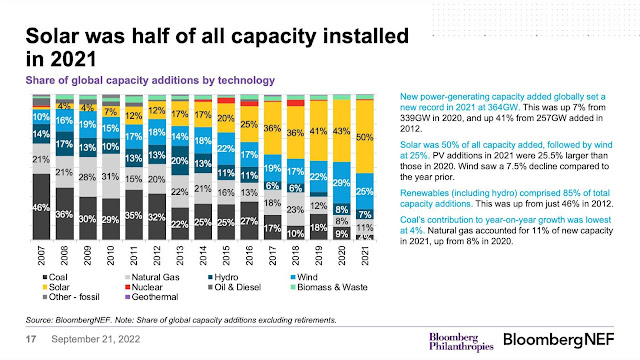From a tweet by Professor Stefan Rahmstorf
 |
| Click on chart to see a clearer image |
- This is *gross* installed capacity, i.e., it doesn't include retired capacity. That implies that total coal capacity prolly *fell* in 2021.
- A grid heavily dependent on solar will require more than 4 hours of storage ― in principle, a grid in the tropics consisting entirely of solar would need ±12 hours of storage, and that ignores seasonal storage. A blend of wind and solar reduces the amount of storage required.
- However, one must also take into account capacity factors: wind 35-41%, solar less, at 20-25%. Given this, the *output* from new wind and new solar would be similar, despite the difference in new capacity built out.
- The probable decline in actual capacity in coal, after taking retirements into account, means that emissions from electricity generation may have fallen in 2021, and may fall again in 2022, though the capacity factor in coal has been low because of overbuilding in China, so that is likely to pick up, and might offset the total decline. Moreover, the pause in shuttering coal power stations in Europe in response to the Ukraine war will also delay the peak for a year or so.
- Gas will still be needed for periods when it's still, cold and cloudy (dunkelflaute) but that would make up about 10% of total electricity generation, which is about where investment in gas is.
In other words, cautious optimism is allowable. Emissions from electricity may be peaking. And they make up ±30% of global emissions. One final point: anybody investing in new coal capacity now is likely to lose their money.

No comments:
Post a Comment